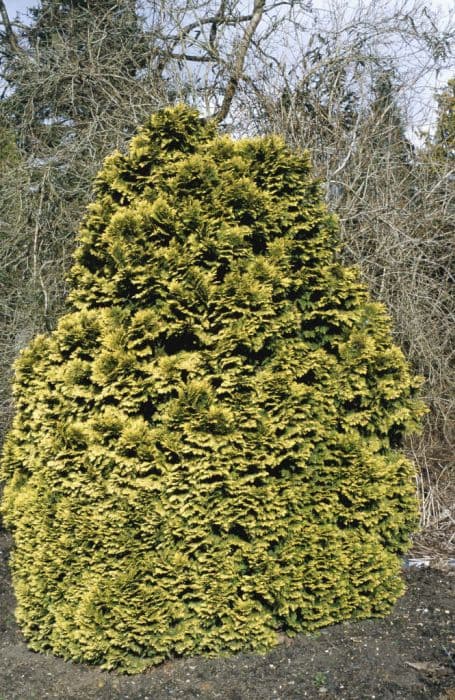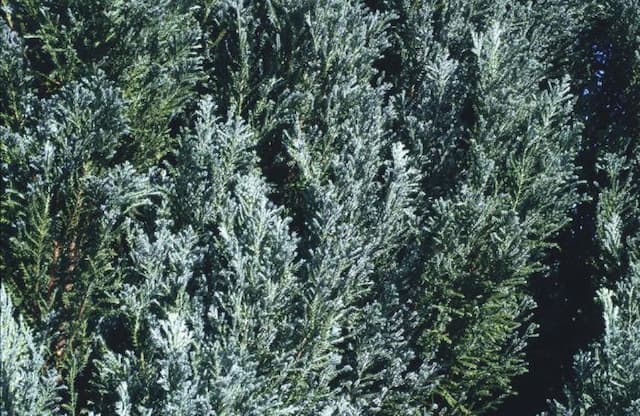Lawson's Cypress Chamaecyparis lawsoniana 'Tamariscifolia'











ABOUT
The plant commonly known as Lawson's cypress 'Tamariscifolia' is an evergreen conifer with a distinctive, refined appearance. This particular selection is appreciated for its dense, low-spread growth habit and layered branches which often gives it a slightly mounded form. The foliage of the Lawson's cypress 'Tamariscifolia' is fine and feathery, providing a soft texture when touched. This foliage comes in a lush, deep green hue which tends to become bluer as cold weather sets in, adding to its year-round interest in the garden. The leaves are scale-like and closely hug the plant’s slender, intricate branches which fan out slightly, creating a sweeping effect. Meanwhile, the bark on the main trunk and larger branches can be somewhat reddish-brown, peeling off in narrow strips, adding another layer of visual appeal. As an evergreen, the Lawson's cypress 'Tamariscifolia' retains its foliage throughout the seasons, making it a reliable player in the landscape for continuous color and structure. This cultivar does not produce conspicuous flowers, but you may occasionally find small cones that are not particularly ornamental. These cones are usually round, small, and may have a slightly woody texture. With its ornamental qualities and evergreen nature, the Lawson's cypress 'Tamariscifolia' is a popular choice for gardens, where it's often used for its textural foliage and attractive growth habit, providing a unique and elegant silhouette throughout the year.
About this plant
 Names
NamesFamily
Cupressaceae.
Synonyms
Lawson's Cypress, Oregon Cedar, Port Orford Cedar.
Common names
Cupressus lawsoniana, Chamaecyparis douglasii, Chamaecyparis lawsoniana var. tamariscifolia, Cupressus lawsoniana var. tamariscifolia.
 Toxicity
ToxicityTo humans
The Port Orford cedar is generally not considered toxic to humans. There is little evidence of serious toxicity from ingesting this plant, but as with many plants, sensitivity can vary between individuals, and consumption is not advisable.
To pets
The Port Orford cedar is not listed as a toxic plant for pets. It should be noted, however, that not all plants have been thoroughly tested for toxicity in animals, and individual animals might have sensitivities or allergic reactions. Ingesting large amounts of plant material can potentially cause gastrointestinal upset in some pets. If a pet is known to have ingested part of this plant and is showing symptoms of distress, it is recommended to consult a veterinarian.
 Characteristics
CharacteristicsLife cycle
Perennials
Foliage type
Evergreen
Color of leaves
Blue-green
Height
3 feet [0.91 meters]
Spread
10 feet [3.05 meters]
Plant type
Shrub
Hardiness zones
5
Native area
North America
Benefits
 General Benefits
General Benefits- Landscape Aesthetics: The Chamaecyparis lawsoniana 'Tamariscifolia', commonly known as Lawson's Cypress, offers a unique texture with its feathery foliage and contributes to the visual interest of landscape designs.
- Privacy Screening: With its dense growing habit, it serves as an effective privacy screen or hedge, shielding gardens and yards from view.
- Windbreak: The thick foliage can act as a windbreak, protecting against strong winds and reducing wind speed in gardens and landscapes.
- Sound Barrier: Lawson's Cypress can help dampen noise pollution when planted in groups, creating quieter outdoor environments.
- Erosion Control: The root systems of these plants help stabilize the soil and prevent erosion on slopes and in areas prone to losing ground.
- Habitat for Wildlife: It provides shelter and nesting sites for birds and other wildlife, enhancing the biodiversity of the garden ecosystem.
- Low Maintenance: Once established, it requires minimal care and can thrive without excessive watering, making it a practical choice for many gardeners.
- Evergreen Foliage: As an evergreen, Lawson's Cypress offers year-round color and structural interest, even in the winter months.
- Adaptability: It is fairly adaptable to a range of soil conditions, which makes it suitable for various landscapes.
- Climate Resilience: Lawson's Cypress is relatively resistant to drought once established, making it a good choice for regions with water scarcity.
 Medical Properties
Medical PropertiesThis plant is not used for medical purposes.
 Air-purifying Qualities
Air-purifying QualitiesThis plant is not specifically known for air purifying qualities.
 Other Uses
Other Uses- Woodworking: The dense, fine-grained wood of the Lawson's Cypress can be used for intricate woodworking projects, including veneers and small wooden items like boxes or picture frames.
- Landscape Bonsai: Due to its slow growth and attractive foliage, Lawson's Cypress can be trained as a bonsai plant for ornamental purposes in gardens or indoor spaces.
- Fragrance Source: The aromatic foliage of Lawson's Cypress can be used in potpourri or as a natural air freshener when placed in cloth sachets.
- Privacy Screens: With its dense foliage, Lawson's Cypress can be planted in rows to create effective privacy screens or living fences in residential areas.
- Theme Gardens: Lawson's Cypress can be included in theme gardens, such as Japanese or Zen gardens, for its aesthetic shape and evergreen qualities.
- Mood Enhancement: The presence of Lawson's Cypress in a garden setting is said to create a peaceful ambiance, enhancing the overall mood and aesthetic of the landscape.
- Windbreaks: These trees can be strategically planted to act as windbreaks to protect gardens, fields, or homes from strong winds.
- Erosion Control: Lawson's Cypress can be used in landscaping projects aimed at controlling erosion due to its root system that holds the soil effectively.
- Holiday Decor: Cut branches of the Lawson's Cypress may be used in holiday wreaths and garlands for their evergreen appearance and pleasant scent.
- Texture Contrast: In garden design, the fine texture of the Lawson's Cypress's foliage can be used to contrast with plants that have larger leaves or flowers, creating interesting visual dynamics.
Interesting Facts
 Feng Shui
Feng ShuiThe Lawson's Cypress is not used in Feng Shui practice.
 Zodiac Sign Compitability
Zodiac Sign CompitabilityThe Lawson's Cypress is not used in astrology practice.
 Plant Symbolism
Plant Symbolism- Longevity: The Lawson's Cypress, like many conifers, can live for many years, and thus it is often associated with endurance and the passage of time.
- Strength: Conifers are known for their hardiness and ability to withstand challenging conditions, which makes the Lawson's Cypress symbolize strength.
- Protection: The thick foliage of the Lawson's Cypress provides shelter for wildlife, representing safety and protection.
- Healing: Historically, some conifers have medicinal properties, and the Lawson's Cypress could be considered a symbol of healing.
 Water
WaterThe Lawson's Cypress should be watered deeply every week during dry periods, with the goal to provide at least 1 to 2 gallons of water for smaller plants and more for larger specimens. Avoid overhead watering to prevent foliar diseases; it's best to apply water directly to the root zone. During the winter when the plant is dormant and the soil retains moisture longer, reduce the frequency but do not let the root ball dry out completely. Always check the soil moisture before watering—Lawson's Cypress prefers moist but not soggy soil.
 Light
LightLawson's Cypress thrives in full sun to partial shade. It performs best when it receives at least 4 to 6 hours of direct sunlight daily. Avoid deep shade locations since insufficient light can result in poor foliage density and plant vigor. An ideal spot is where the plant can enjoy the morning sun and be protected from the intense afternoon heat.
 Temperature
TemperatureLawson's Cypress can handle a range of temperatures and it is cold hardy down to about -20 degrees Fahrenheit. It prefers a typical temperate climate with temperatures ranging from 60 to 70 degrees Fahrenheit. Extreme heat above 90 degrees Fahrenheit could cause stress, so it's important to provide adequate water during hot spells and consider its placement regarding heat reflection from buildings or paved surfaces.
 Pruning
PruningPruning the Lawson's Cypress is necessary to shape the plant, remove dead or diseased branches, and encourage a dense growth habit. The best time to prune is in late winter or early spring before new growth begins. Pruning should be done conservatively, as harsh cuts can be difficult for the plant to recover from. It should not be pruned back into old wood that lacks green foliage, as it may not regrow.
 Cleaning
CleaningAs needed
 Soil
SoilLawson's Cypress 'Tamariscifolia' prefers well-draining soil with a mixture of loam, peat, and sharp sand to ensure adequate drainage and root aeration. An optimal pH range for this conifer is slightly acidic to neutral, around pH 5.5 to 7.
 Repotting
RepottingLawson's Cypress 'Tamariscifolia' does not require frequent repotting; it can be repotted every 2 to 4 years, ensuring that the plant does not become pot-bound and the soil remains fresh and nutrient-rich.
 Humidity & Misting
Humidity & MistingLawson's Cypress 'Tamariscifolia' thrives in moderate to high humidity levels, ideally between 40% and 70%. Although it is adaptable, sustaining these humidity levels will help the plant maintain its health and foliage quality.
 Suitable locations
Suitable locationsIndoor
Not suitable for indoor cultivation due to its size and light needs.
Outdoor
Plant in sunny spot with moist, well-drained soil. Prune to shape.
Hardiness zone
5-8 USDA
 Life cycle
Life cycleLawson's Cypress 'Tamariscifolia' begins its life as a seed, typically requiring well-drained soil and partial to full sunlight to germinate. After germination, seedlings go through a juvenile phase, developing a dense, ground-hugging form with soft, feathery foliage that's a striking blue-green. As it matures, it transitions into the adult phase, characterized by a wider, conical shape reaching up to 2-3 feet tall and 8-10 feet wide, with scale-like leaves. The plant then becomes reproductive, producing small, spherical cones that mature and release seeds, completing the reproductive cycle. In its mature phase, Lawson's Cypress 'Tamariscifolia' is relatively slow-growing and can live several decades in optimal conditions. Pruning in early life can shape the growth, but once established, the plant requires minimal maintenance, persisting with notable disease and pest resistance.
 Propogation
PropogationPropogation time
Spring-Early Summer
The most popular method of propagating the Lawson's Cypress 'Tamariscifolia' is through semi-hardwood cuttings. This technique is often carried out in late summer or early fall. To propagate, one would begin by choosing a healthy parent plant and taking a 4 to 6-inch cutting (approximately 10 to 15 centimeters) from a semi-hardened shoot that has not flowered this season. The cutting should include several sets of needles. The lower needles are stripped off, and the cut end can be dipped in rooting hormone to encourage root development. The prepared cutting should then be placed in a moist, well-draining soil mix, ensuring that several needle sets are above the soil line. The cuttings are generally kept under greenhouse conditions with high humidity and indirect light until roots are established, which usually takes several weeks to a few months.









